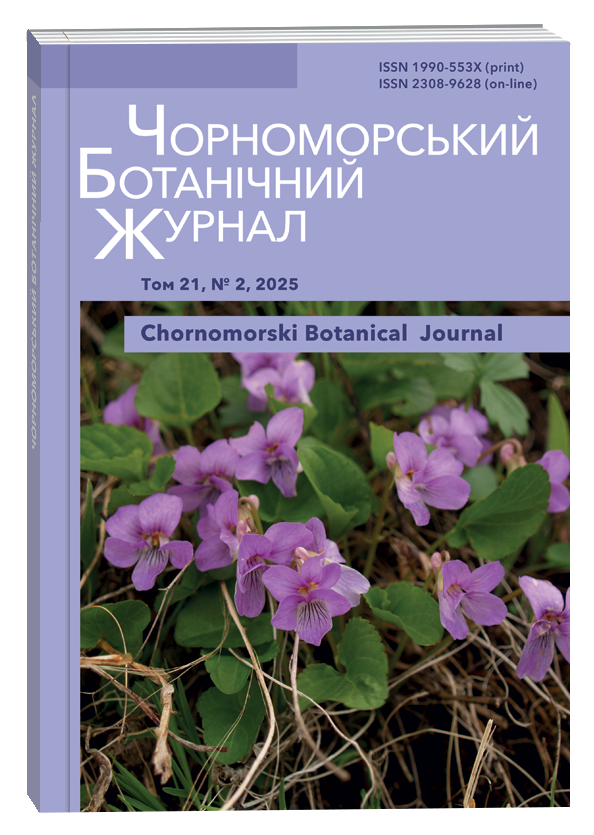Osmunda regalis (Osmundaceae) – новий вид для флори України
DOI:
https://doi.org/10.32999/ksu1990-553X/2025-21-2-3Ключові слова:
біорізноманіття, папороті, рідкіcний вид, хорологія, морфологія, нові місцезнаходження, Поліська низовина, Ківерцівський Національний природний парк «Цуманська Пуща»Анотація
Osmunda regalis – вид папоротей, поширений в атлантичній та субатлантичній частинах Європи, Середземномор’ї, на Балканському півострові та Кавказі. У Центральній і Східній Європі цей вид трапляється рідше. Згідно з останніми номенклатурними списками та іншими публікаціями, O. regalis відсутній у флорі України. Тим не менш, найближча популяція цієї папороті знаходиться досить близько від України – менш ніж за 0,5 км від кордону. Деякі автори припускали, що O. regalis потенційно може зростати на прилеглих територіях України, але попередні дослідження не дали результатів. У 2023 році в Ківерцівському Національному природному парку «Цуманська пуща» (Ківерцівський район, Волинська область) виявлено першу особину O. regalis. У 2024 році неподалік знайшли другу. На сьогоднішній день популяція представлена двома особинами. Обидві вони фертильні та здатні утворювати спори. Популяцію виявлено в 30-річному сосново-березовому вторинному лісі з низьким видовим багатством. Вид виявлено у рослинному угрупованні з вузькими амплітудами екологічної толерантності. Місцезростання характеризуються вологими, кислими та бідними на мінеральне живлення (зокрема азот) дерново-підзолистими ґрунтами. Омброрежим є субаридним, а режим континентальності клімату знаходиться між геміокеанічним і субконтинентальним. Серед досліджених факторів кислотність ґрунту, вміст азоту в ґрунті та вологість клімату (омброрежим) були лімітуючими факторами для цього рослинного угруповання. Такі умови вказують на те, що виявлена популяція вразлива, оскільки рослини ростуть на межі екологічної толерантності. На сьогодні в Україні відома лише одна популяція, що складається з двох особин. Враховуючи це, O. regalis визнано критично зникаючим (CR; B2ac(iii, iv) + D) видом рослин флори України та має бути включений до наступного видання Червоної книги. Оскільки досліджуваний вид є новим для флори України, у статті подано морфологічний опис O. regalis та ключ до його ідентифікації.
Посилання
Amigo, J., Pulgar, Í., & Izco, J. (2009). Evidence of riverside ash tree forests in southern Galicia (northwestern Spain). Mediterranean Botany 30: 181–189.
Birks, H. H., & Paus, A. (1991). Osmunda regalis in the early Holocene of western Norway. Nordic journal of botany 11 (6): 635–640.
Didukh, Ya.P. (2011). The ecological scales for the species of Ukrainian flora and their use in synphytoindication. Kyiv: Phytosociocentre, 176 p.
Fomin, A.V. (1934). Chistous – Osmunda L. In: Komarov V.L. & Ilin M.M. (eds.). Flora USSR. Vol. 1. Leningrad–Moscow: Publisher of Academy of Science of USSR, P. 88–89. (in Russian)
GBIF (2025). GBIF Home Page. https://www.gbif.org
Gdula, A.K., Dyderski, M.K., & Jagodziński, A.M. (2014). Habitat preferences of royal fern Osmunda regalis L. in the ‘Baszków’ nature reserve. Folia Forestalia Polonica 56 (4): 171–178.
Gergely, K. (ed.). (2007). A magyarországi edényes flóra veszélyeztetett fajai. Sopron: Lővér Print, 73 p. (in Hungarian)
iNaturalist. (2025). iNaturalis Home. https://www.inaturalist.org/home
IUCN (2012). IUCN Red List Categories and Criteria: Version 3.1. Second edition. Gland, Switzerland and Cambridge, UK: IUCN, 32 p.
Kaźmierczakowa, R. (ed.) (2016). Polska czerwona lista paprotników i roślin kwiatowych. Kraków: Instytut Ochrony Przyrody Polskiej Akademii Nauk, 44 p.
Kuzemko, A.A., Didukh, Ya.P., Onyshchenko, V.A., Sheffer, Ya. (eds.) (2018). National Habitat Catalogue of Ukraine. Kyiv: FOP Klymenko Yu.Ya., 442 p.
Landi, M., & Angiolini, C. (2008). Habitat characteristics and vegetation context of Osmunda regalis L. at the southern edge of its distribution in Europe. Botanica Helvetica 118: 45–57.
Lehnert, M., Monjau, T., & Rosche, Ch. (2024). Synopsis of Osmunda (royal ferns; Osmundaceae): towards reconciliation of genetic and biogeographic patterns with morphologic variation. Botanical Journal of the Lennean Society 205: 341–364.
Metzgar, J. S., Skog, J. E., Zimmer, E. A., & Pryer, K. M. (2008). The paraphyly of Osmunda is confirmed by phylogenetic analyses of seven plastid loci. Systematic Botany 33 (1): 31–36.
Mosyakin, S.L. & Fedoronchuk, M.M. (1999). Vascular plants of Ukraine. A nomenclature checklist. Kiev, 345 p.
Noé N. (2024). GBIF Occurences. QGIS GBIF API. https://github.com/BelgianBiodiversityPlatform/qgis-gbif-api
Osmunda regalis L. in GBIF Secretariat (2023). GBIF Backbone Taxonomy. Checklist dataset https://doi.org/10.15468/39omei
Parfenov, V.I. (ed.) (2009). Flora Belarusi. Sosuditye rasteniya. Vol. 1. Minsk: Belarusskaya Kniga, 198 p. (in Russian)
POWO (2025). Plants of the World Online. Facilitated by the Royal Botanic Gardens, Kew. Published on the Internet. https://powo.science.kew.org/
Prokudin, Yu.N. (ed.). (1987). Opredelitel’ vysshykh rasteniy Ukrainy. Kiev: Naukova Dumka, 548 p. (in Russian)
Resolution of the Ministry of Natural Resources and Environment Protection of The Republic of Belarus No. 10 Dated March 14, 2025. On rare and endangered species of wild animals and wild plants included in the Red Book of the Republic of Belarus.
Terletskyi, V.K., Antoniuk, Yu.M., Batiura, E. V., Vashchuk, L.I., Kudryk, V.V., Markov, V.V., Marchenko, P.D., Makhnovets, V.O., Romaniuk, N.Z., Filipenko, A.B. & Cherniak, E.F. (1995). Sudynni roslyny Volynskoi Oblasti. Flora I kultyvary. Lutsk: Publisher of L. Ukrainka Volynian State University, 124 p. (in Ukrainian)
The Norwegian Biodiversity Information Centre (2021). Results from the 2021 Red List for Species. The Norwegian Red List of Species 2021.
Thiers, B. (2016). Index Herbariorum. A global directory of public herbaria and associated staff. New York Botanical Garden's Virtual Herbarium. https://sweetgum.nybg.org/science/ih/
UkrBIN (2024). UkrBIN, Database on Biodiversity Information. https://www.ukrbin.com
Vasheka, O.V. & Bezsmertna, O.O. (2012). Atlas paporotey flory Ukrainy. Kyiv: Palyvoda, 160 p. (in Ukrainian)
Webb, D.A. (1964). Osmunda L. In: Tutin, T.G., Heywood, V.H., Burges, N.A., Valentine, D.H., Walters, S.M., & Webb, D.A. (eds.). Flora Europaea. Vol. 1. Cambridge: University Press: 9.
Zając, A. & Zając, M. (2001). Atlas rozmieszczenia roślin naczyniowych w Polsce. Kraków: Nakładem Pracowni Chorologii Komputerowej Instytutu Botaniki Uniwersytetu Jagiellońskiego, 714 p. (in Polish)




